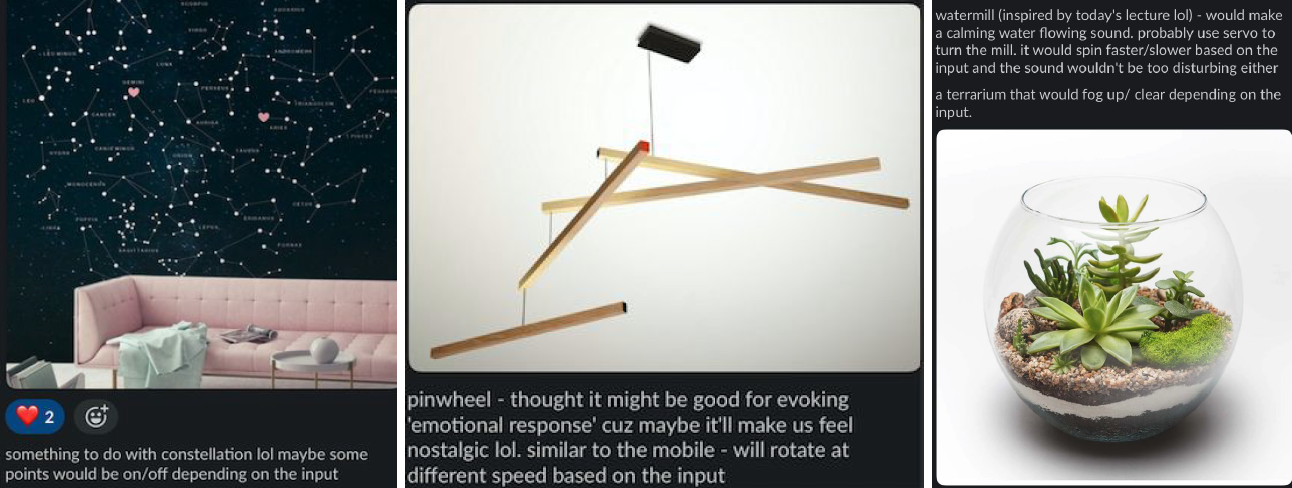ambient water mill
ambient transfer of information - how can it help us in daily life?
Designing for the Internet of Things | Carnegie Mellon University | Authors: April Wu, Jay Qin, Zongpeng Yu, Claire Koh
What is it?
A Mini Water Mill that alleviates the stress and depletion of focus associated with sitting on a chair for too long.
Who is it for?
For people who are constantly in front of the screen, not realizing they have been sitting down for way too long. Their effectiveness at work might be decreasing without them realizing.
How does it work?
The Mini Water Mill looks out for a constant pressure from a sensor built into a user’s chair. If the reading has been constant for too long a time, the water mill is activated. Once activated, the water mill spins to provide some background noise and movements. We hope that such ambient noise and movement will improve the effectiveness of work.
early brainstorming
Constellation Wall: Points would be turned on/off based on input
Suspension mobile/pinwheel: would turn (and also maybe light up) based on the input
Terrarium: will fog up/clear depending on the input
Physical object inspiration:
An object that can be placed like a piece of decoration in a room and will emanate white noise –– similar to the water flow sound of a watermill.
CONCEPT
an object that can bring awareness and a more physical representation of the user’s lifestyle through ambient intervention.
Mistake along the way
In our first discussion, we decided on the concept of a spinning water mill that spins faster as the user sits on the chair for an extended period of time. After some hands-on, we became a bit unsure of whether such a device can be categorized as an ambient one. As users are “annoyed” by the rapidly spinning wheels to the point where they have to stand up and reset the system, the device is essentially forcing the user to notice it and take action. In short, our original concept was more of a device of forceful enforcement than ambient encouragement. Deeper understanding of what it means to be an ambient device Synthesizing our findings with our previous readings in class, we realized that an ambient device should only subtly influence our behaviors in the background. It should nudge us into doing something but also give us a choice not to. It is not the goal of an ambient device to mandate or restrict our actions. It should just sit there, and through some minor changes to its behavior, alters our behaviors ever so slightly each time.
Renewed concept
We brainstormed once again and made a very simple tweak to our concept: instead of having the water mill spinning faster as we sit to the point where we cannot ignore it, we should have the water mill spinning slower and slower to the point where we start noticing something is missing and we start wondering what.
For individuals who rely on the peaceful background noise of the spinning water mill, they would notice that the sound is slowly diminishing. And since that person would most likely want the sound to be back on, he would stand up, take a break, and sit down again to have the system reset and start spinning again.
For individuals who don’t rely on the background noise, the watermill simply stops spinning without them noticing. The person can continue to focus on his work. Nevertheless, such a device would still remind the user, once he’s done with work and realized that the watermill has stopped spinning, that he has been sitting on the chair for way too long and they should change his habits a little bit.
This renewed concept is in stark contrast to the original “in-the-face” awakening and is a much better fit into the category of ambient device.
PROTOTYPE
Components:
Hardware:
- Motor
- Pressure sensor
- Resistors
- Particle argon
- Housing
- Power
Input:
- Pressure sensor in the chair to detect how long people sit on the chair
Output:
- Speed of the motor(how fast the mill spins) depending on how long people sit





